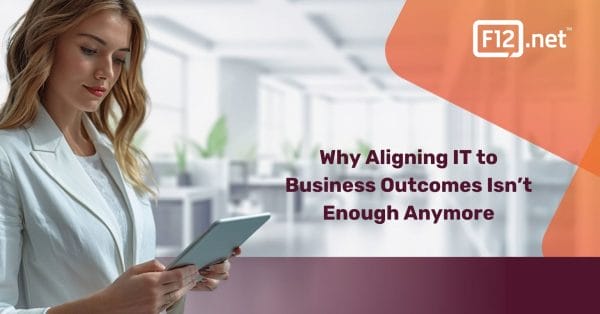
F12 Business Innovation Executive Michael Contento defines the term and uses three case studies to illustrate how to apply digital transformation to your own business.
Insights
“Digital Transformation” has become a buzzed-about phrase in IT in the last few years. But what does the term really mean? In this recent webinar, F12 Business Innovation Executive Michael Contento and Chief Marketing Officer Devon Gillard break down the term, and share case studies of digital transformation at work, simplifying and transforming three of their client’s businesses—and could be applied to your business, too.
What is digital transformation—and how do you implement it?
First, let’s break down the phrase into two parts: digital and transformation. The digital part is, really, how do we embrace technology? The transformation part is about, how do we start working smarter and not harder? How do we use this technology to start building better processes and workflows to achieve greater success? At F12, we start with automation to simplify tasks within an organization. Ultimately, where digital transformation really gains a lot of success is with time. Our most valuable commodity is time. If we can minimize the time we’re spending on tasks, it’s going to help us achieve greater outcomes. [7:14]
How can digital transformation impact a business?
With over 26 years of working with our clients, we’ve realized that our best approach is to break the business into three buckets: Revenue, cost and profitability. When we look at business development revenue, we ask: How do we automate certain tasks to increase revenue and improve outcomes? We know we’re trying to generate revenue, but are we following the right processes? The following diagram is a high-level pictorial representation of what we seek. It indicates how we start designing the best possible transformation within each department. [11:08]

Don’t abandon processes that work. For example, you can continue to use Excel spreadsheets to organize your data, but by using certain automation, we can harness data within a client’s Excel spreadsheets, without going directly to an ERP [enterprise resource planning] system or without jumping into a full CRM [customer relationship management] system. We can give them metrics and they can start driving their organization in a more refined way. [16:20]
Case Study #1: Volunteer-Supported Charity
A not-for-profit organization was manually registering thousands of volunteers for its annual parade. It was a very manual-based process to onboard a volunteer—each of the 2,000 entries required 30 minutes of paid staff time. Instead, we implemented a simplified database that allowed volunteers to enter their own information. It expedited the way volunteers were onboarded, and how the organization communicated with them throughout the journey. This saved 1,000 hours of paid staff time for an annual savings of $50,000. Based on the project cost of $6,500, the new tech saved $43,500 annually or an ROI of nearly 7x. [20:29]
Case Study #2: Electrical Equipment Distributor
A national electrical equipment distributor’s database was only accessible inside the physical office, making it inefficient for their sales reps, who were on the road across the country. The situation required sales reps to have to call in orders, which may or may not have reflected the latest inventories. We deployed a sales CRM that allowed staff to log in through an iPad or laptop to access the inventory and pricing in real-time. Sales increased 20%—not because of the demand, but because the staff was able to get to the information faster, and it was readily available at any given time. So essentially, we just empowered the revenue team, the business development team with instant information. [23:51]
Case Study #3: Amusement Park Concession
One of the biggest challenges with this amusement park was the refrigeration and freezer units that had to be manually monitored. Changes in temperature could cause food spoilage. Our solution was to implement wifi-enabled IoT thermometers, providing live feeds on temperature gauges. So what was really great about this is that it didn’t just empower the leadership team to do more, it empowered the workers—they were excited about it, and they really embraced the technology to not worry as much. Our estimated ROI on this was that they would save close to $75,000 in wages and food spoilage. [26:40]
Digital Transformation doesn’t have to be a complete overhaul of your systems.
It doesn’t have to be all or nothing. It’s about really understanding your people and your processes and figuring out how do we digitally support our staff to achieve greater success? So digital transformation is more than operational excellence, more than just technology. It’s not just about getting a new network or getting a new firewall, it’s about operationally, how do we achieve more? [29:29]
Book a consultation with our Business Innovation Executive.



